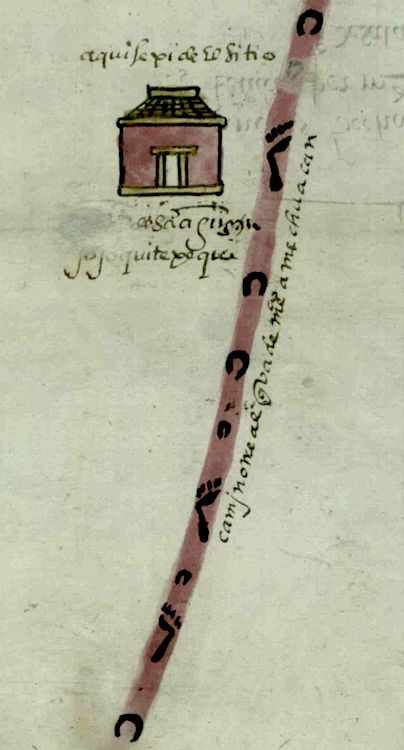otli (T2737:13:8r)
This is an iconographic element found on a pictorial manuscript from Almoloyan, Toluca Valley. The road (otli), shown as if from a bird’s-eye view, is shaded in red. The surface of the road has human footprints and u-shaped elements standing for horses’ hooves. While the rendition of the road is typical for Nahua-authored pictorials of its era, the only gloss related to this road is written in Spanish, which refers to it as a camino real (see Gloss, below). The road runs from a slightly southeastern to northwestern direction (the image of the road here has been rotated to save space in the present entry, but see the historical contextualizing image for its original orientation).
Robert Haskett
The pictorial upon which iconographic element of the house dates from c. 1578. According to the Spanish gloss on the manuscript, the road is the “camino real que va de Mexico a Mechuacan” (royal road that goes from Mexico City to Michoacán). On its left it passes by a red building glossed as a casa at a place called “jojoquitepeque” (Xocoquitepec), as well as an area with the gloss “aqui le pide El Sitio” (here he requests the site). This refers to a request for a viceregal grant of a “sitio de estancia de ganado menor” (ranch for small livestock) adjacent to the borders of Almoloyan by an individual named Gonzalo de Salazar near. For more information see Ruz Barrio, Miguel Ángel, “Las huellas del ganado en el valle de Matlatzinco en el siglo XVI a través de los mapas hispanoindígenas/Tracing Livestock in the Matlatzinco Valley in the 16th century through Hispanic-Indigenous Maps,” Relaciones, Estudios de historia y Sociedad, 40:160 (dic. 2019), Epub 19 Nov. 2020.
Footprint glyphs have a wide range of translations. In this collection, so far, we can attest to yauh, xo, pano, -pan, paina, temo, nemi, quetza, otli, iyaquic hualiloti, huallauh, tepal, tetepotztoca, totoco, otlatoca, -tihui, and the vowel "o." Other research (Herrera et al, 2005, 64) points to additional terms, including: choloa, tlaloa, totoyoa, eco, aci, quiza, maxalihui, centlacxitl, and xocpalli.
Robert Haskett
camino real
Camino Real
Robert Haskett
1578
Robert Haskett
road, camino
ot(li), road, https://nahuatl.wired-humanities.org/content/otli
camino
Single-page codex, Archivo General de la Nación, México, Ramo de Tierras Vol. 2737, Exp. 13, Fol. 8r.
The Archivo General de la Nación (AGN), México, holds the original manuscript. This image is published here under a Creative Commons license, asking that you cite the AGN and this Visual Lexicon of Aztec Hieroglyphs.



